CER591: Stereotyping and the Media Essay - Third Year
VerifiedAdded on 2023/01/10
|7
|1870
|55
Essay
AI Summary
This academic essay critically discusses and evaluates the influence of mass media in developing negative stereotypes. It begins by defining stereotyping and outlining its forms within the media, including religious, gender, and racial stereotyping. The essay then explores the historical influences on stereotyping, particularly focusing on social-political factors such as colonization and cultural perceptions. Theoretical explanations, including the stereotype theory and media dependency theory, are analyzed to understand how media shapes stereotypes. The essay then delves into racial stereotyping, examining its impact on society, including the perpetuation of white superiority stereotypes and resulting consequences like the adoption of Western diets and instances of police brutality. The essay is fully Harvard referenced and written in the third person.
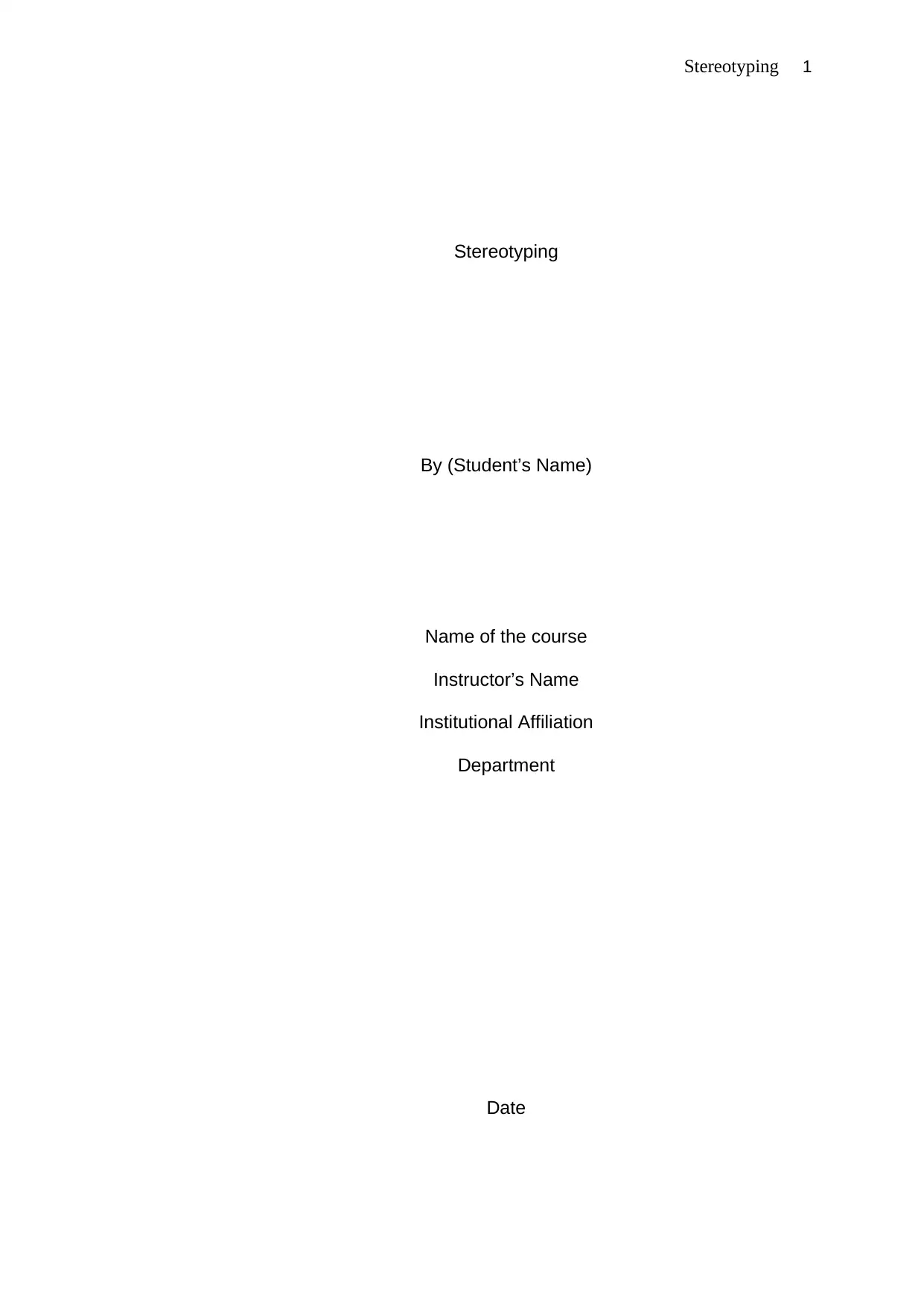
Stereotyping 1
Stereotyping
By (Student’s Name)
Name of the course
Instructor’s Name
Institutional Affiliation
Department
Date
Stereotyping
By (Student’s Name)
Name of the course
Instructor’s Name
Institutional Affiliation
Department
Date
Paraphrase This Document
Need a fresh take? Get an instant paraphrase of this document with our AI Paraphraser
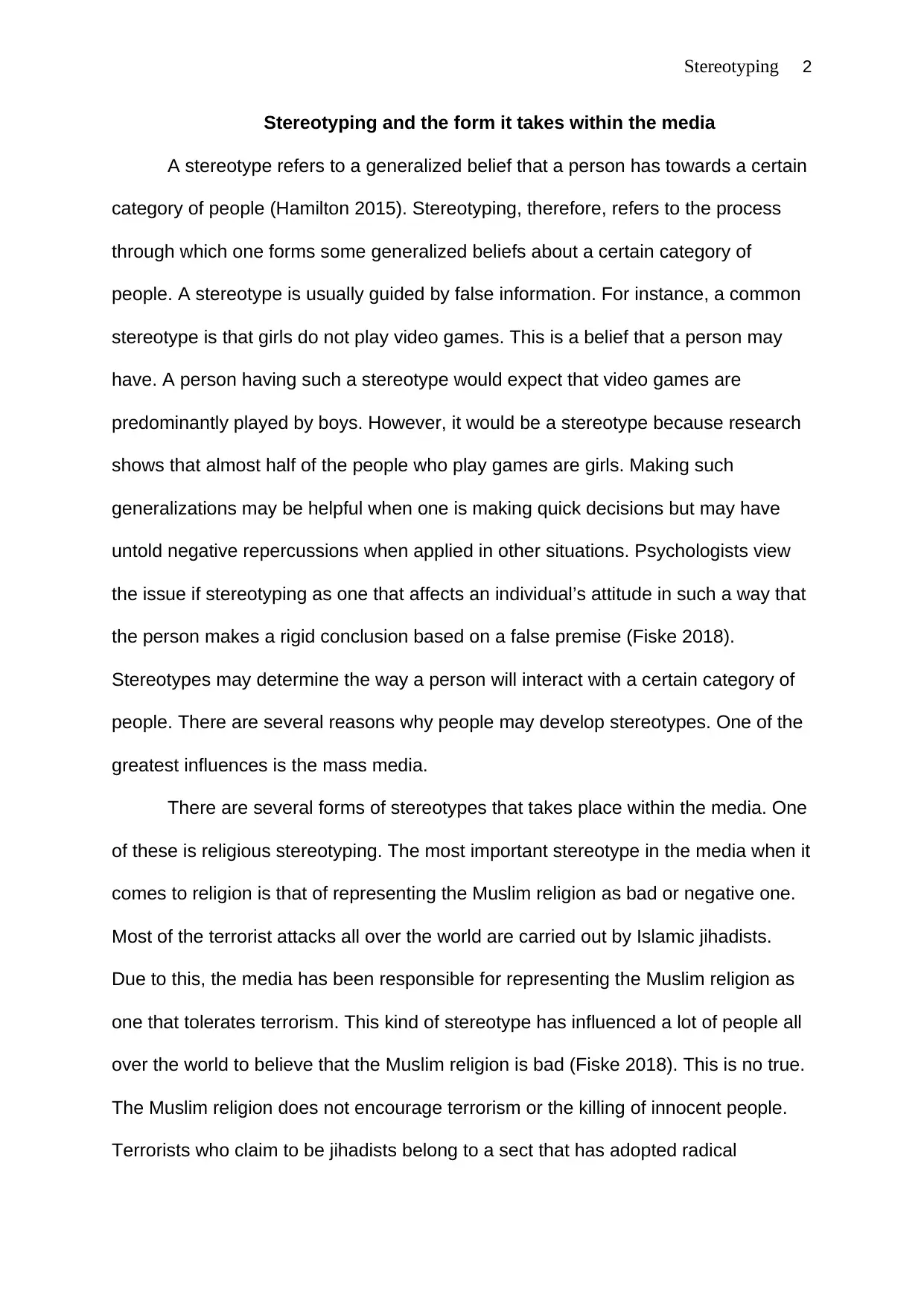
Stereotyping 2
Stereotyping and the form it takes within the media
A stereotype refers to a generalized belief that a person has towards a certain
category of people (Hamilton 2015). Stereotyping, therefore, refers to the process
through which one forms some generalized beliefs about a certain category of
people. A stereotype is usually guided by false information. For instance, a common
stereotype is that girls do not play video games. This is a belief that a person may
have. A person having such a stereotype would expect that video games are
predominantly played by boys. However, it would be a stereotype because research
shows that almost half of the people who play games are girls. Making such
generalizations may be helpful when one is making quick decisions but may have
untold negative repercussions when applied in other situations. Psychologists view
the issue if stereotyping as one that affects an individual’s attitude in such a way that
the person makes a rigid conclusion based on a false premise (Fiske 2018).
Stereotypes may determine the way a person will interact with a certain category of
people. There are several reasons why people may develop stereotypes. One of the
greatest influences is the mass media.
There are several forms of stereotypes that takes place within the media. One
of these is religious stereotyping. The most important stereotype in the media when it
comes to religion is that of representing the Muslim religion as bad or negative one.
Most of the terrorist attacks all over the world are carried out by Islamic jihadists.
Due to this, the media has been responsible for representing the Muslim religion as
one that tolerates terrorism. This kind of stereotype has influenced a lot of people all
over the world to believe that the Muslim religion is bad (Fiske 2018). This is no true.
The Muslim religion does not encourage terrorism or the killing of innocent people.
Terrorists who claim to be jihadists belong to a sect that has adopted radical
Stereotyping and the form it takes within the media
A stereotype refers to a generalized belief that a person has towards a certain
category of people (Hamilton 2015). Stereotyping, therefore, refers to the process
through which one forms some generalized beliefs about a certain category of
people. A stereotype is usually guided by false information. For instance, a common
stereotype is that girls do not play video games. This is a belief that a person may
have. A person having such a stereotype would expect that video games are
predominantly played by boys. However, it would be a stereotype because research
shows that almost half of the people who play games are girls. Making such
generalizations may be helpful when one is making quick decisions but may have
untold negative repercussions when applied in other situations. Psychologists view
the issue if stereotyping as one that affects an individual’s attitude in such a way that
the person makes a rigid conclusion based on a false premise (Fiske 2018).
Stereotypes may determine the way a person will interact with a certain category of
people. There are several reasons why people may develop stereotypes. One of the
greatest influences is the mass media.
There are several forms of stereotypes that takes place within the media. One
of these is religious stereotyping. The most important stereotype in the media when it
comes to religion is that of representing the Muslim religion as bad or negative one.
Most of the terrorist attacks all over the world are carried out by Islamic jihadists.
Due to this, the media has been responsible for representing the Muslim religion as
one that tolerates terrorism. This kind of stereotype has influenced a lot of people all
over the world to believe that the Muslim religion is bad (Fiske 2018). This is no true.
The Muslim religion does not encourage terrorism or the killing of innocent people.
Terrorists who claim to be jihadists belong to a sect that has adopted radical
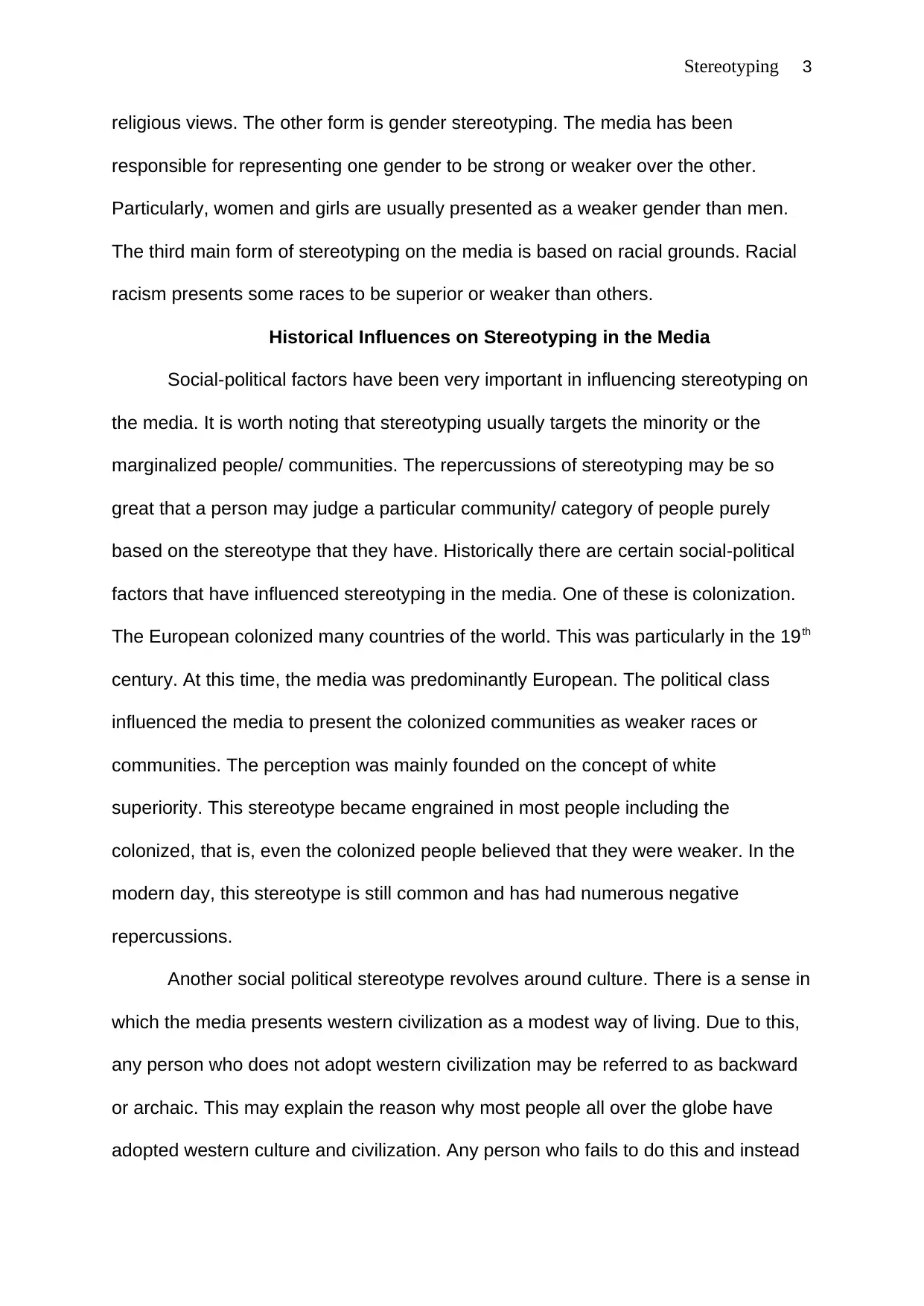
Stereotyping 3
religious views. The other form is gender stereotyping. The media has been
responsible for representing one gender to be strong or weaker over the other.
Particularly, women and girls are usually presented as a weaker gender than men.
The third main form of stereotyping on the media is based on racial grounds. Racial
racism presents some races to be superior or weaker than others.
Historical Influences on Stereotyping in the Media
Social-political factors have been very important in influencing stereotyping on
the media. It is worth noting that stereotyping usually targets the minority or the
marginalized people/ communities. The repercussions of stereotyping may be so
great that a person may judge a particular community/ category of people purely
based on the stereotype that they have. Historically there are certain social-political
factors that have influenced stereotyping in the media. One of these is colonization.
The European colonized many countries of the world. This was particularly in the 19th
century. At this time, the media was predominantly European. The political class
influenced the media to present the colonized communities as weaker races or
communities. The perception was mainly founded on the concept of white
superiority. This stereotype became engrained in most people including the
colonized, that is, even the colonized people believed that they were weaker. In the
modern day, this stereotype is still common and has had numerous negative
repercussions.
Another social political stereotype revolves around culture. There is a sense in
which the media presents western civilization as a modest way of living. Due to this,
any person who does not adopt western civilization may be referred to as backward
or archaic. This may explain the reason why most people all over the globe have
adopted western culture and civilization. Any person who fails to do this and instead
religious views. The other form is gender stereotyping. The media has been
responsible for representing one gender to be strong or weaker over the other.
Particularly, women and girls are usually presented as a weaker gender than men.
The third main form of stereotyping on the media is based on racial grounds. Racial
racism presents some races to be superior or weaker than others.
Historical Influences on Stereotyping in the Media
Social-political factors have been very important in influencing stereotyping on
the media. It is worth noting that stereotyping usually targets the minority or the
marginalized people/ communities. The repercussions of stereotyping may be so
great that a person may judge a particular community/ category of people purely
based on the stereotype that they have. Historically there are certain social-political
factors that have influenced stereotyping in the media. One of these is colonization.
The European colonized many countries of the world. This was particularly in the 19th
century. At this time, the media was predominantly European. The political class
influenced the media to present the colonized communities as weaker races or
communities. The perception was mainly founded on the concept of white
superiority. This stereotype became engrained in most people including the
colonized, that is, even the colonized people believed that they were weaker. In the
modern day, this stereotype is still common and has had numerous negative
repercussions.
Another social political stereotype revolves around culture. There is a sense in
which the media presents western civilization as a modest way of living. Due to this,
any person who does not adopt western civilization may be referred to as backward
or archaic. This may explain the reason why most people all over the globe have
adopted western culture and civilization. Any person who fails to do this and instead
⊘ This is a preview!⊘
Do you want full access?
Subscribe today to unlock all pages.

Trusted by 1+ million students worldwide
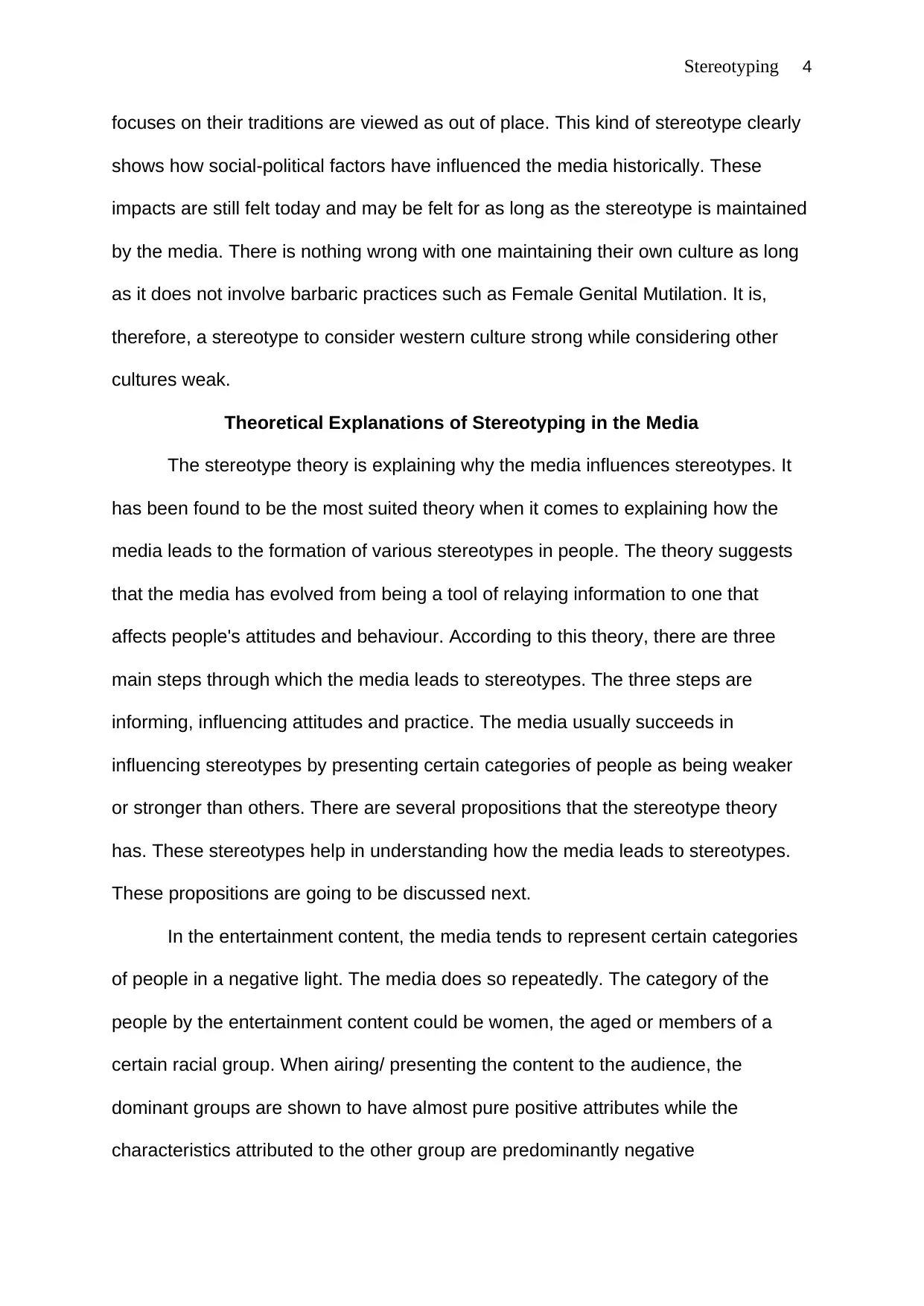
Stereotyping 4
focuses on their traditions are viewed as out of place. This kind of stereotype clearly
shows how social-political factors have influenced the media historically. These
impacts are still felt today and may be felt for as long as the stereotype is maintained
by the media. There is nothing wrong with one maintaining their own culture as long
as it does not involve barbaric practices such as Female Genital Mutilation. It is,
therefore, a stereotype to consider western culture strong while considering other
cultures weak.
Theoretical Explanations of Stereotyping in the Media
The stereotype theory is explaining why the media influences stereotypes. It
has been found to be the most suited theory when it comes to explaining how the
media leads to the formation of various stereotypes in people. The theory suggests
that the media has evolved from being a tool of relaying information to one that
affects people's attitudes and behaviour. According to this theory, there are three
main steps through which the media leads to stereotypes. The three steps are
informing, influencing attitudes and practice. The media usually succeeds in
influencing stereotypes by presenting certain categories of people as being weaker
or stronger than others. There are several propositions that the stereotype theory
has. These stereotypes help in understanding how the media leads to stereotypes.
These propositions are going to be discussed next.
In the entertainment content, the media tends to represent certain categories
of people in a negative light. The media does so repeatedly. The category of the
people by the entertainment content could be women, the aged or members of a
certain racial group. When airing/ presenting the content to the audience, the
dominant groups are shown to have almost pure positive attributes while the
characteristics attributed to the other group are predominantly negative
focuses on their traditions are viewed as out of place. This kind of stereotype clearly
shows how social-political factors have influenced the media historically. These
impacts are still felt today and may be felt for as long as the stereotype is maintained
by the media. There is nothing wrong with one maintaining their own culture as long
as it does not involve barbaric practices such as Female Genital Mutilation. It is,
therefore, a stereotype to consider western culture strong while considering other
cultures weak.
Theoretical Explanations of Stereotyping in the Media
The stereotype theory is explaining why the media influences stereotypes. It
has been found to be the most suited theory when it comes to explaining how the
media leads to the formation of various stereotypes in people. The theory suggests
that the media has evolved from being a tool of relaying information to one that
affects people's attitudes and behaviour. According to this theory, there are three
main steps through which the media leads to stereotypes. The three steps are
informing, influencing attitudes and practice. The media usually succeeds in
influencing stereotypes by presenting certain categories of people as being weaker
or stronger than others. There are several propositions that the stereotype theory
has. These stereotypes help in understanding how the media leads to stereotypes.
These propositions are going to be discussed next.
In the entertainment content, the media tends to represent certain categories
of people in a negative light. The media does so repeatedly. The category of the
people by the entertainment content could be women, the aged or members of a
certain racial group. When airing/ presenting the content to the audience, the
dominant groups are shown to have almost pure positive attributes while the
characteristics attributed to the other group are predominantly negative
Paraphrase This Document
Need a fresh take? Get an instant paraphrase of this document with our AI Paraphraser
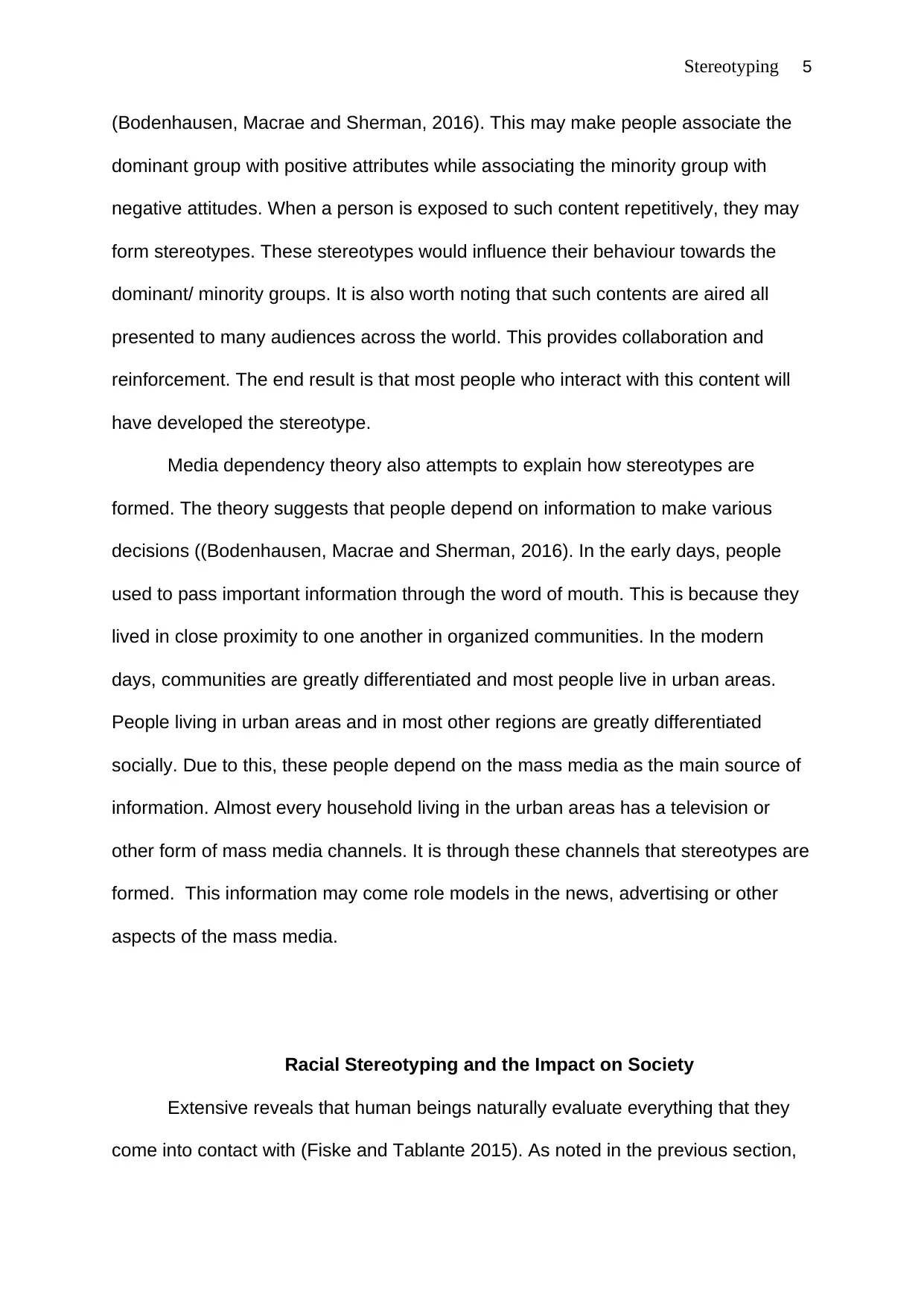
Stereotyping 5
(Bodenhausen, Macrae and Sherman, 2016). This may make people associate the
dominant group with positive attributes while associating the minority group with
negative attitudes. When a person is exposed to such content repetitively, they may
form stereotypes. These stereotypes would influence their behaviour towards the
dominant/ minority groups. It is also worth noting that such contents are aired all
presented to many audiences across the world. This provides collaboration and
reinforcement. The end result is that most people who interact with this content will
have developed the stereotype.
Media dependency theory also attempts to explain how stereotypes are
formed. The theory suggests that people depend on information to make various
decisions ((Bodenhausen, Macrae and Sherman, 2016). In the early days, people
used to pass important information through the word of mouth. This is because they
lived in close proximity to one another in organized communities. In the modern
days, communities are greatly differentiated and most people live in urban areas.
People living in urban areas and in most other regions are greatly differentiated
socially. Due to this, these people depend on the mass media as the main source of
information. Almost every household living in the urban areas has a television or
other form of mass media channels. It is through these channels that stereotypes are
formed. This information may come role models in the news, advertising or other
aspects of the mass media.
Racial Stereotyping and the Impact on Society
Extensive reveals that human beings naturally evaluate everything that they
come into contact with (Fiske and Tablante 2015). As noted in the previous section,
(Bodenhausen, Macrae and Sherman, 2016). This may make people associate the
dominant group with positive attributes while associating the minority group with
negative attitudes. When a person is exposed to such content repetitively, they may
form stereotypes. These stereotypes would influence their behaviour towards the
dominant/ minority groups. It is also worth noting that such contents are aired all
presented to many audiences across the world. This provides collaboration and
reinforcement. The end result is that most people who interact with this content will
have developed the stereotype.
Media dependency theory also attempts to explain how stereotypes are
formed. The theory suggests that people depend on information to make various
decisions ((Bodenhausen, Macrae and Sherman, 2016). In the early days, people
used to pass important information through the word of mouth. This is because they
lived in close proximity to one another in organized communities. In the modern
days, communities are greatly differentiated and most people live in urban areas.
People living in urban areas and in most other regions are greatly differentiated
socially. Due to this, these people depend on the mass media as the main source of
information. Almost every household living in the urban areas has a television or
other form of mass media channels. It is through these channels that stereotypes are
formed. This information may come role models in the news, advertising or other
aspects of the mass media.
Racial Stereotyping and the Impact on Society
Extensive reveals that human beings naturally evaluate everything that they
come into contact with (Fiske and Tablante 2015). As noted in the previous section,
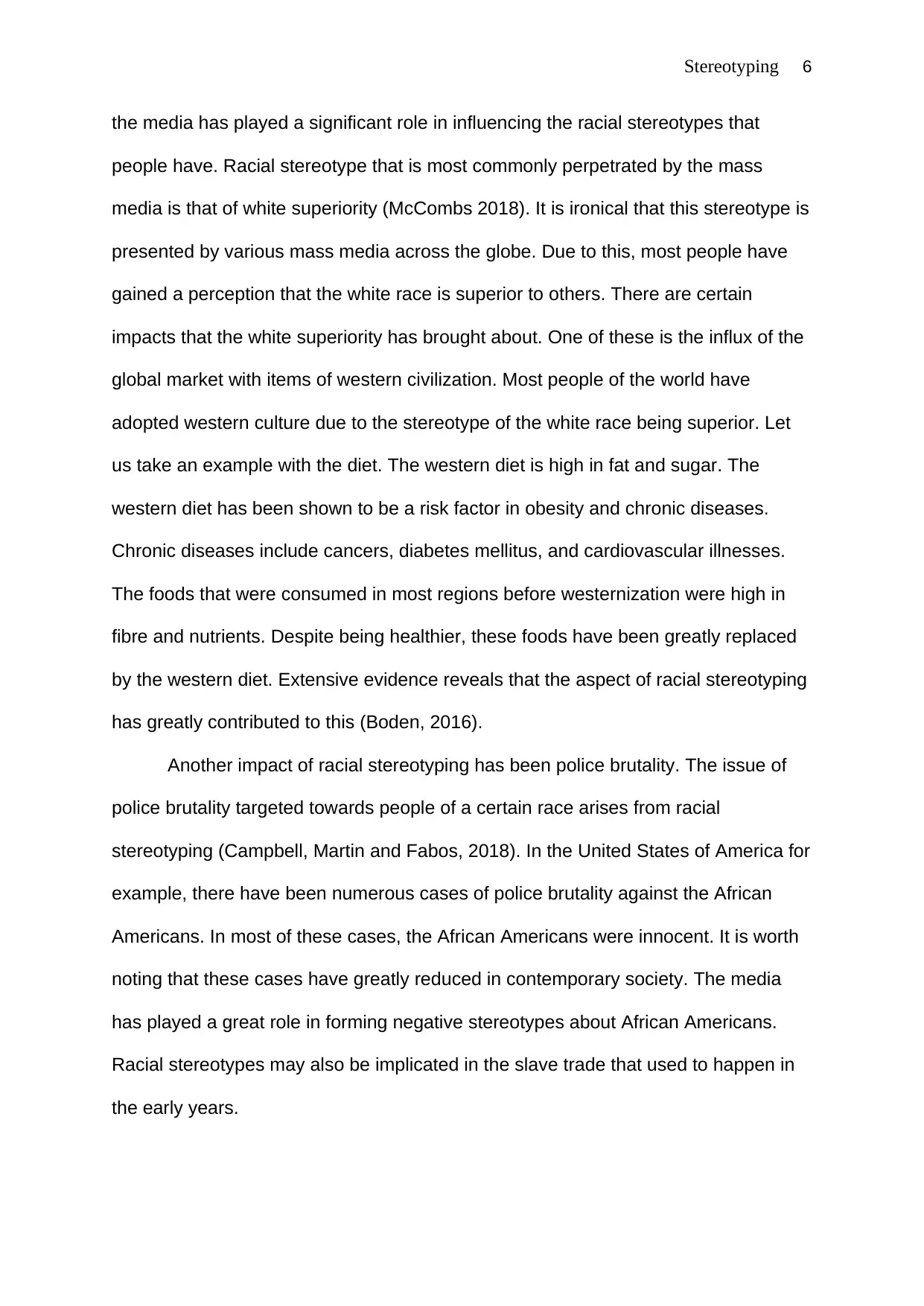
Stereotyping 6
the media has played a significant role in influencing the racial stereotypes that
people have. Racial stereotype that is most commonly perpetrated by the mass
media is that of white superiority (McCombs 2018). It is ironical that this stereotype is
presented by various mass media across the globe. Due to this, most people have
gained a perception that the white race is superior to others. There are certain
impacts that the white superiority has brought about. One of these is the influx of the
global market with items of western civilization. Most people of the world have
adopted western culture due to the stereotype of the white race being superior. Let
us take an example with the diet. The western diet is high in fat and sugar. The
western diet has been shown to be a risk factor in obesity and chronic diseases.
Chronic diseases include cancers, diabetes mellitus, and cardiovascular illnesses.
The foods that were consumed in most regions before westernization were high in
fibre and nutrients. Despite being healthier, these foods have been greatly replaced
by the western diet. Extensive evidence reveals that the aspect of racial stereotyping
has greatly contributed to this (Boden, 2016).
Another impact of racial stereotyping has been police brutality. The issue of
police brutality targeted towards people of a certain race arises from racial
stereotyping (Campbell, Martin and Fabos, 2018). In the United States of America for
example, there have been numerous cases of police brutality against the African
Americans. In most of these cases, the African Americans were innocent. It is worth
noting that these cases have greatly reduced in contemporary society. The media
has played a great role in forming negative stereotypes about African Americans.
Racial stereotypes may also be implicated in the slave trade that used to happen in
the early years.
the media has played a significant role in influencing the racial stereotypes that
people have. Racial stereotype that is most commonly perpetrated by the mass
media is that of white superiority (McCombs 2018). It is ironical that this stereotype is
presented by various mass media across the globe. Due to this, most people have
gained a perception that the white race is superior to others. There are certain
impacts that the white superiority has brought about. One of these is the influx of the
global market with items of western civilization. Most people of the world have
adopted western culture due to the stereotype of the white race being superior. Let
us take an example with the diet. The western diet is high in fat and sugar. The
western diet has been shown to be a risk factor in obesity and chronic diseases.
Chronic diseases include cancers, diabetes mellitus, and cardiovascular illnesses.
The foods that were consumed in most regions before westernization were high in
fibre and nutrients. Despite being healthier, these foods have been greatly replaced
by the western diet. Extensive evidence reveals that the aspect of racial stereotyping
has greatly contributed to this (Boden, 2016).
Another impact of racial stereotyping has been police brutality. The issue of
police brutality targeted towards people of a certain race arises from racial
stereotyping (Campbell, Martin and Fabos, 2018). In the United States of America for
example, there have been numerous cases of police brutality against the African
Americans. In most of these cases, the African Americans were innocent. It is worth
noting that these cases have greatly reduced in contemporary society. The media
has played a great role in forming negative stereotypes about African Americans.
Racial stereotypes may also be implicated in the slave trade that used to happen in
the early years.
⊘ This is a preview!⊘
Do you want full access?
Subscribe today to unlock all pages.

Trusted by 1+ million students worldwide
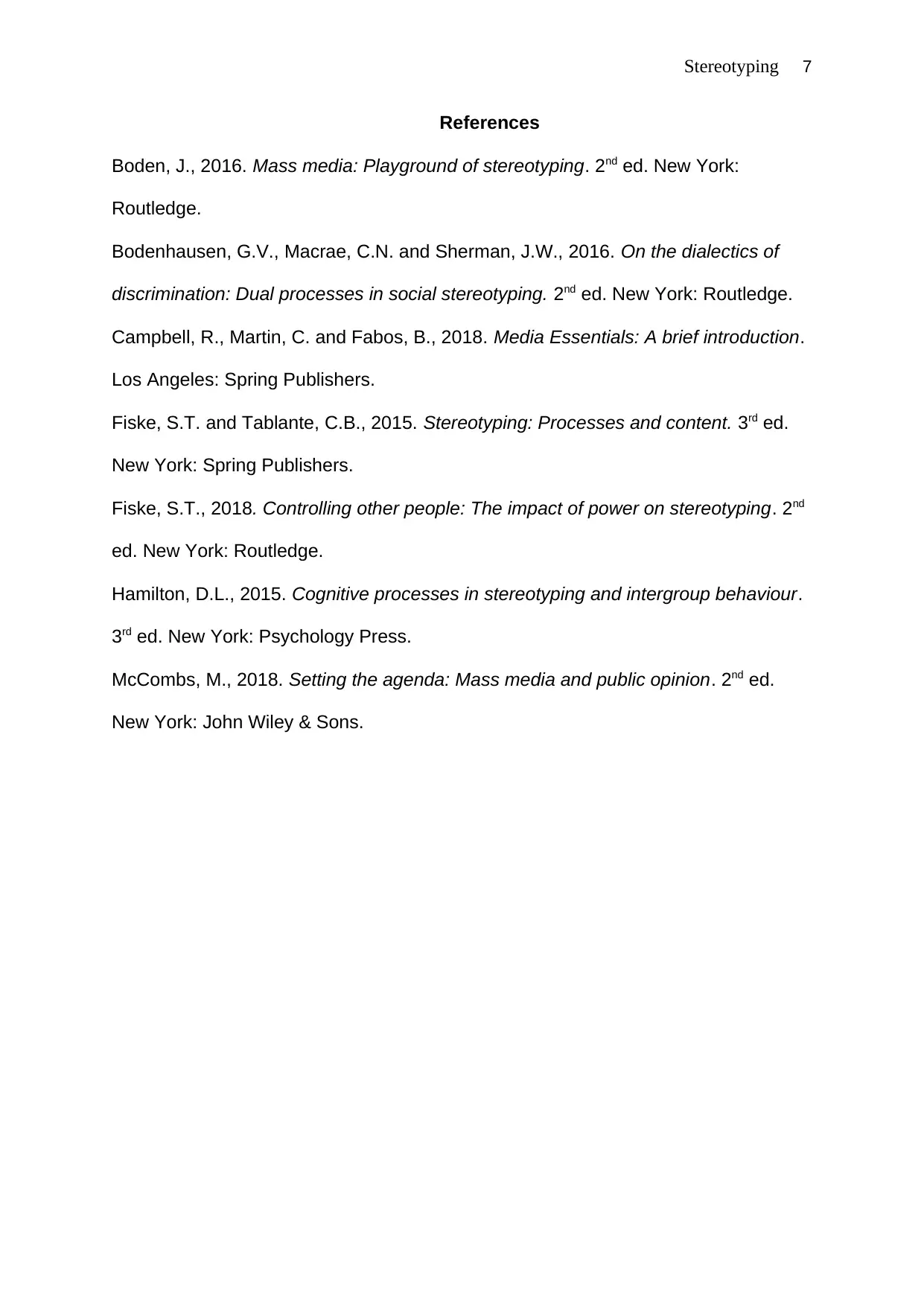
Stereotyping 7
References
Boden, J., 2016. Mass media: Playground of stereotyping. 2nd ed. New York:
Routledge.
Bodenhausen, G.V., Macrae, C.N. and Sherman, J.W., 2016. On the dialectics of
discrimination: Dual processes in social stereotyping. 2nd ed. New York: Routledge.
Campbell, R., Martin, C. and Fabos, B., 2018. Media Essentials: A brief introduction.
Los Angeles: Spring Publishers.
Fiske, S.T. and Tablante, C.B., 2015. Stereotyping: Processes and content. 3rd ed.
New York: Spring Publishers.
Fiske, S.T., 2018. Controlling other people: The impact of power on stereotyping. 2nd
ed. New York: Routledge.
Hamilton, D.L., 2015. Cognitive processes in stereotyping and intergroup behaviour.
3rd ed. New York: Psychology Press.
McCombs, M., 2018. Setting the agenda: Mass media and public opinion. 2nd ed.
New York: John Wiley & Sons.
References
Boden, J., 2016. Mass media: Playground of stereotyping. 2nd ed. New York:
Routledge.
Bodenhausen, G.V., Macrae, C.N. and Sherman, J.W., 2016. On the dialectics of
discrimination: Dual processes in social stereotyping. 2nd ed. New York: Routledge.
Campbell, R., Martin, C. and Fabos, B., 2018. Media Essentials: A brief introduction.
Los Angeles: Spring Publishers.
Fiske, S.T. and Tablante, C.B., 2015. Stereotyping: Processes and content. 3rd ed.
New York: Spring Publishers.
Fiske, S.T., 2018. Controlling other people: The impact of power on stereotyping. 2nd
ed. New York: Routledge.
Hamilton, D.L., 2015. Cognitive processes in stereotyping and intergroup behaviour.
3rd ed. New York: Psychology Press.
McCombs, M., 2018. Setting the agenda: Mass media and public opinion. 2nd ed.
New York: John Wiley & Sons.
1 out of 7
Your All-in-One AI-Powered Toolkit for Academic Success.
+13062052269
info@desklib.com
Available 24*7 on WhatsApp / Email
![[object Object]](/_next/static/media/star-bottom.7253800d.svg)
Unlock your academic potential
Copyright © 2020–2025 A2Z Services. All Rights Reserved. Developed and managed by ZUCOL.